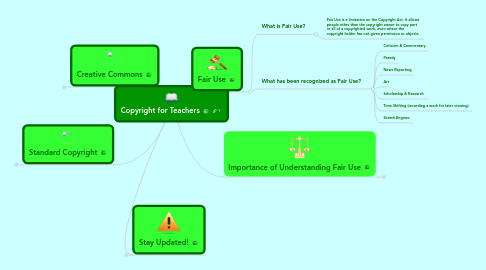
1. Standard Copyright
1.1. U.S. copyright law gives the author/creator or owner of an original creative work exclusive right to: reproduce or distribute the original work to the public, create new works based upon the original work, and perform or display the work publicly.
2. Creative Commons
2.1. CC consists of a set of copyright licenses and tools that creates a balance in the "all rights reserved" setting that copyright law creates. This gives everyone a simple way to keep their copyright while allowing certain uses of their work.
3. Stay Updated!
3.1. Additional Sources on Fair Use
3.1.1. http://cyberlaw.stanford.edu/taxonomy/term/374
3.1.2. http://www.centerforsocialmedia.org/resources/publications/fair_use_in_online_video
3.1.3. http://fairuse.stanford.edu/
3.2. Additional Sources on Copyright Laws
3.2.1. http://www.copyright.gov/
3.2.2. http://www.copyrighthistory.org/
3.2.3. http://www.centerforsocialmedia.org/resources/publications/the_good_bad_and_confusing
3.3. Other suggestions!
3.3.1. The rules, laws and guidelines that govern copyright laws and faire use are constantly changing and still developing. Therefore, signing up for an RSS reader (Netvibes, GoogleReader) would be efficient for an educator! Your reader will update you on every new piece of information on blogs, articles, etc. regarding copyright laws and Fair Use that you subscribe to! Stay informed and protect yourself!
4. Importance of Understanding Fair Use
4.1. Teachers need to understand that Fair Use permits them to use and do things that would otherwise be considered illegal under copyright laws. This will give teachers the ability to make the right decisions about what kind of work and sharing they can use in a classroom. For example, a teacher might want to display pictures of the Pearl Harbor attack in order to effectively teach a history lesson on WWII.
4.2. Fair Use is decided on a case-by-case basis after balancing these following four factors:
4.2.1. Purpose and character of the use of copyrighted work: Transformative (is the new work the same or different?) or Commercial/Noncommercial (will you make money from it or not?)
4.2.2. Nature of the copyrighted work (is the copied work factual or creative?)
4.2.3. Amount and sustainability of the portion used (how much is too much?)
4.2.4. Effect of the use on the market for or value of the work (is it substituting for the original or serving a different audience?
5. Fair Use
5.1. What is Fair Use?
5.1.1. Fair Use is a limitation on the Copyright Act. It allows people other than the copyright owner to copy part or all of a copyrighted work, even where the copyright holder has not given permission or objects.
5.2. What has been recognized as Fair Use?
5.2.1. Criticism & Commentary
5.2.2. Parody
5.2.3. News Reporting
5.2.4. Art
5.2.5. Scholarship & Research
5.2.6. Time Shifting (recording a work for later viewing)
5.2.7. Search Engines
